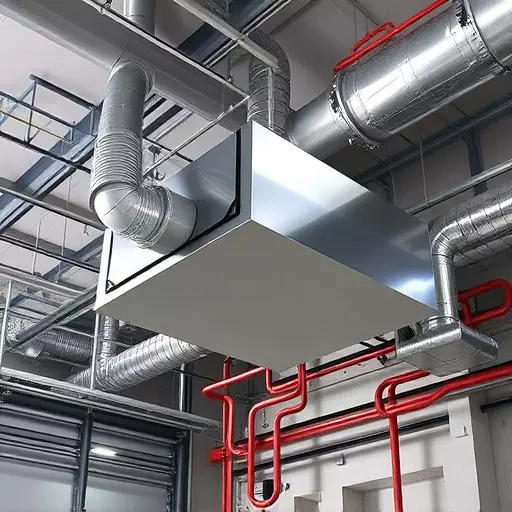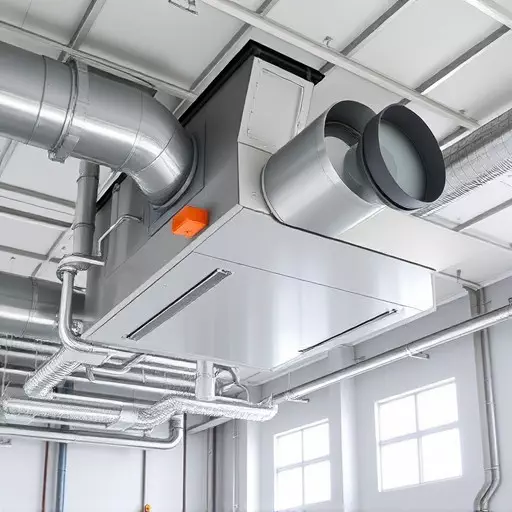Industrial ventilation solutions, combining exhaust and supply systems, are vital for maintaining air quality, worker safety, and productivity in factories and manufacturing facilities. Exhaust systems remove hazardous fumes and pollutants, while supply systems deliver clean air, ensuring optimal working conditions. These tailored solutions, backed by real-time monitoring and advanced control systems, comply with global safety regulations, enhance operational efficiency, and create healthier work environments. Their successful implementation is evident in case studies, demonstrating reduced hazards and improved productivity in diverse industries like manufacturing and food processing.
Industrial ventilation standards are paramount for ensuring worker safety and optimizing productivity. This comprehensive guide explores essential aspects of industrial ventilation solutions, from understanding the basics to selecting the right system for your facility. We delve into types like exhaust and supply ventilation, key components, safety regulations, best practices, and real-world case studies. Discover how effective ventilation systems not only meet compliance but also enhance overall facility performance.
- Understanding Industrial Ventilation: The Basics
- Types of Industrial Ventilation Systems: Exhaust and Supply
- Key Components of Effective Ventilation Solutions
- Safety Standards and Regulations for Industrial Ventilation
- Selecting the Right Ventilation System for Your Facility
- Best Practices for Implementing and Maintaining Ventilation Systems
- Case Studies: Successful Industrial Ventilation Solutions in Action
Understanding Industrial Ventilation: The Basics
Industrial ventilation is a critical aspect of workplace safety and productivity, especially in factories and manufacturing facilities. It involves the strategic use of exhaust ventilation solutions to remove hazardous fumes, dust, and other pollutants from the air. By understanding the basics of industrial ventilation, businesses can implement effective strategies to create a healthier and safer work environment for their employees.
The primary goal is to maintain indoor air quality by promoting proper circulation and filtration. This is achieved through a combination of supply ventilation systems that introduce clean air into workspaces and exhaust ventilation solutions that remove contaminated air. Balancing these two components ensures optimal air exchange, minimizing the risk of respiratory issues and other health problems among workers. Effective industrial ventilation not only improves employee well-being but also enhances overall operational efficiency.
Types of Industrial Ventilation Systems: Exhaust and Supply
In the realm of industrial safety and environmental control, industrial ventilation solutions play a pivotal role in ensuring worker well-being and maintaining air quality. Among the various industrial ventilation systems, two primary categories stand out: exhaust ventilation solutions and supply ventilation systems.
Exhaust ventilation focuses on removing contaminated or hazardous gases from enclosed spaces. This is achieved through strategically placed exhaust fans that draw out harmful substances, replacing them with cleaner air from outside sources. Conversely, supply ventilation systems introduce fresh air into work areas, diluting potential risks and maintaining a safe atmosphere. These systems are particularly crucial in environments where the risk of airborne contaminants is high, such as manufacturing facilities or chemical plants. By combining effective exhaust and supply ventilation strategies, employers can create robust industrial ventilation solutions tailored to their specific operational needs.
Key Components of Effective Ventilation Solutions
Effective industrial ventilation solutions are multifaceted, encompassing both exhaust and supply ventilation systems to ensure optimal air quality and worker safety in industrial settings. The key components include high-efficiency filters that trap harmful particles and gases, powerful fans and blowers that facilitate efficient airflow, and strategically placed vents and ductwork to distribute clean air evenly throughout the workspace.
Additionally, modern control systems play a crucial role, allowing precise adjustments to ventilation rates based on real-time conditions. These systems integrate sensors that monitor temperature, humidity, and contaminant levels, ensuring that the industrial ventilation solutions adapt dynamically to meet changing needs. This holistic approach not only enhances productivity by maintaining a healthy work environment but also complies with stringent safety regulations.
Safety Standards and Regulations for Industrial Ventilation
In the realm of industrial safety, establishing robust ventilation standards is paramount to safeguard workers and ensure operational efficiency. Regulatory bodies worldwide have implemented stringent guidelines for industrial ventilation solutions, focusing on exhaust ventilation systems and supply ventilation equipment. These regulations aim to mitigate risks associated with hazardous fumes, dust, and other airborne contaminants, thereby enhancing workplace wellness.
Compliance with these safety standards involves meticulously designed exhaust ventilation solutions that remove noxious gases and particulate matter from work areas. Simultaneously, supply ventilation systems are engineered to provide clean, breathable air, ensuring a healthy indoor environment. Regular inspections and maintenance of these industrial ventilation systems are vital to guarantee their optimal performance and adherence to the set regulations.
Selecting the Right Ventilation System for Your Facility
Selecting the appropriate ventilation system is a critical step in ensuring a safe and productive work environment within your industrial facility. The right choice between exhaust ventilation solutions and supply ventilation systems depends on various factors, including the nature of operations, the types of materials handled, and the specific health and safety requirements.
Industrial ventilation solutions should aim to maintain optimal air quality by controlling temperature, removing harmful contaminants, and providing adequate oxygen supply. Exhaust ventilation systems are particularly effective for facilities where toxic or flammable substances are used, as they help remove potentially dangerous build-up of gases or dust. Conversely, supply ventilation systems deliver fresh air into the workspace, enhancing overall air quality and worker comfort, especially in environments with high heat generation or humidity levels.
Best Practices for Implementing and Maintaining Ventilation Systems
Implementing and maintaining effective ventilation systems is a cornerstone of ensuring worker safety and productivity in industrial settings. The first step involves assessing specific workplace hazards and employee needs, which guides the design and installation of either exhaust ventilation solutions or supply ventilation systems. Best practices dictate that these systems should be tailored to minimize exposure to harmful dusts, gases, vapors, and other airborne contaminants.
Regular maintenance is crucial for keeping ventilation systems at peak performance. This includes routine inspections to identify leaks or blockages, as well as cleaning and replacing filters as needed. Utilizing advanced monitoring technologies can also help in optimising system efficiency. By regularly measuring air quality and system performance, businesses can promptly address issues and make data-driven decisions to enhance their industrial ventilation solutions, ultimately creating a safer, healthier working environment.
Case Studies: Successful Industrial Ventilation Solutions in Action
In the realm of industrial safety and productivity, effective ventilation is a game-changer. Case studies across various industries highlight successful implementations of industrial ventilation solutions that have transformed work environments. For instance, in manufacturing hubs known for their bustling activity and complex machinery, well-designed exhaust ventilation solutions have significantly reduced hazardous fumes and improved air quality. These systems meticulously extract contaminated air, replacing it with clean supply ventilation systems, thereby enhancing worker safety and comfort.
A study of a steel mill revealed that by implementing advanced extraction points and ductwork configurations, the concentration of toxic gases was lowered by over 80%. Similarly, in food processing facilities, tailored ventilation strategies have not only improved air circulation but also prevented cross-contamination, ensuring product quality. These real-world examples underscore the critical role of strategic industrial ventilation solutions in creating healthier, more productive workplaces.


